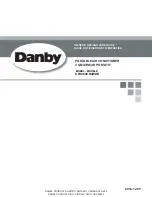
3. Selecting installation locations
-&_Caution----------------
• Be sure to grasp the hanger bracket when carrying the air
conditioner with the package being opened or already
opened. Do not put any stress to other parts especially the
refrigerant piping, drain piping and flange.
• If temperature within the ceiling interlayer may exceed 30
°
C
and the humidity over HR80%, thicken the insulation material
of the unit body.
Adopt glass wool or EPE (thickness at least 10mm and
able to be gathered in the ceiling opening) as the
insulation material.
(1 )Select the installation location that meets the following
conditions and get approval of the customer.
• Where the cool and warm air spreads evenly in the room.
• Where there is no obstacles in the air passage.
• Where drainage can be ensured.
• Where the ceiling lower surface is not inclined.
• Where there is sufficient strength to withstand the mass
of the indoor unit (if the strength is insufficient, the indoor
unit may vibrate and get in contact with the ceiling and
generate unpleasant chattering noise).
• Where a space sufficient for installation and service can
be ensured.
(Refer to Figures 1 and 2)
• Where the piping length between the indoor and the
outdoor units is ensured within the allowable length.
(Refer to the installation manual attached to the outdoor
unit.)
• Where there is no risk of flammable gas leak.
(Refer to the installation manual of outdoor unit.)
C
al
�l'"='==============="=F-if-----
-----'-
-
�
Figure 1
iil1il
j?
t2
Air outlet
Figure 2
[Note]
More tHan 150
':
tr'
More than 150
Unit: mm
0
�
• Install the indoor unit, outdoor unit, power wiring and
transmission wiring at least 1 m away from televisions
and radios to prevent image interference and noise.
(Depending on the radio waves, a distance of 1 m may
not be sufficient to eliminate the interference in some
instances.)
(2) Perform installation with a lifting screw. Study if the
ceiling is strong enough to hold the weight of the indoor
unit. If the ceiling is not strong enough, reinforce the
ceiling in advance.
(Refer to the spacing marked on the packaging box
and check if it is necessary to reinforce.)
(3)Ceiling height
The indoor unit can be mounted to the ceiling with height
not exceeding 3 m. However, if the ceiling height
exceeds 2.7m, make the onsite settings using the remote
controller. Refer to the chapter of "12. Field settings and
test run".
4. Preparations before installation
(1 )Determine the relative positions of the ceiling opening,
units and lifting screw. (Unit [mm])
[When mounting by matching with panel]
[Unit:
mm]
(
1390 decorative oanel
1355 CCeliniz ooenins:)
1250 (distance betwen lifting screw)
1210(lndoor unit)
I]
-
J.
s=
·2
] g
C
� 1
�i
�
".a
> 0
g g]
".j:; 0
t
E�
:s � g
Oo
0"'
�
"'
iil
"'
�
.... -
�
�
"'
-
Figure 3
[Refer to the following figure]
17
:,i
\!}
L....I
"'
@:
-c:
5e=,-
-c::: ';:=,-
:,i
]
]
.,
�
560
<Ceiling opening><Overlaps of the decorative panel and the ceiling>
Figure 4
@:
(2)If necessary, punching through the opening needed for
installation on the ceiling. (For locations already having
had the ceiling)
17
• For dimensions of the ceiling opening, refer to the paper
board for ceiling opening (within the bottom box).
• Prepare all the pipes (refrigerant piping and drain
piping) and electric wires (remote controller wiring,
indoor and outdoor units' connection wiring and power
wiring) to be connected to the indoor units before
installation, so that they can be connected to the indoor
units immediately after completing installation.
• After punching through the ceiling opening, in order to
keep the ceiling flat and prevent it form vibrating, it may
be necessary to reinforce the ceiling bracket. Consult
your builder for details.
{3)Install the suspension screw (use MB or M10 bolts)
• In order to withstand the weight of the units, use
foundation bolts for locations already having had the
ceiling and embedded anchor bolts, buried anchor bolts
5
Содержание VRV FXKQ32AV16
Страница 14: ...13...







































